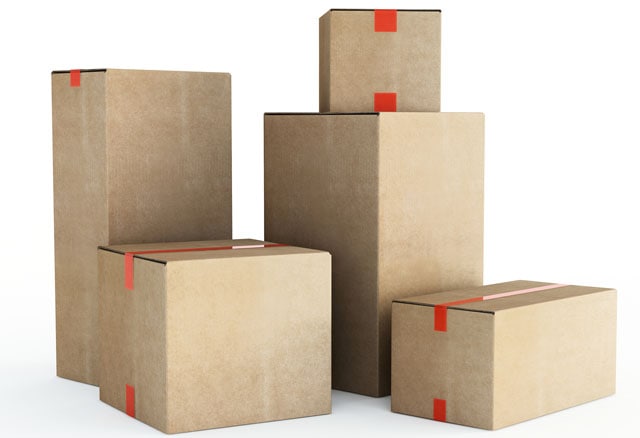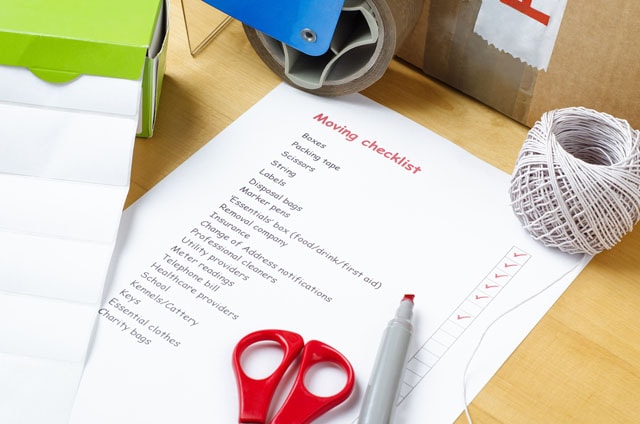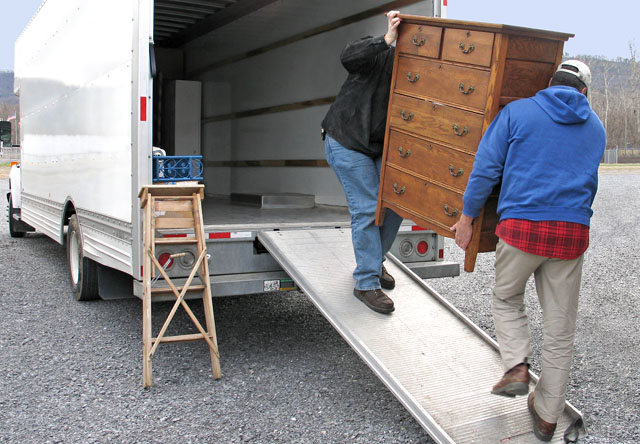Let’s face it, moving is stressful. That’s why we’ve created an epic moving checklist to help you stay on track. We’re here to help you figure out exactly what you should be doing before, during, and even after your move. Moving all your belongings from one place to another is hard, and so is relocating your life in general. But, let’s not forget that moving to a new place is an exciting time! With some guidance and this 8-week guide to your upcoming move, you’ll be sure to have everything done between now and the big day, leaving you plenty of time to celebrate.
8 weeks before you move:
So, you’re 8 weeks out! Close, but not too close. It’s important for you to start planning ahead for every aspect of your move. The good news? We’ve got you covered. We’re not going to lie, there’s a lot to do to prepare. Yet, you’ll be thankful you started early and had this epic moving checklist to ensure you stay on top of your to-do list.
1. Create a “moving” file or folder on Google Drive to store quotes, receipts, and records related to your move. For example, how much is Dan the mover quoting you? Was that price for 10 or 15 boxes? You’re not going to be able to remember all of the details. So throw them in a document for easy reference.
2. Schedule in-home estimates with an Updater Certified Moving Company. Make sure you hire someone you feel you can trust by clicking the button below.
3. Create a realistic budget for moving expenses. We know you want to hire professional movers, but that new sectional and that wine fridge, but priorities, right?
4. Read over documents from your movers before signing anything. Don’t let contracts intimidate you by learning about the documents you’ll be receiving ahead of time. We can’t emphasize enough how important this is, there’s a reason it’s #4 on our list.
5. Request time off work for moving day. If you can, plan to take off and move on a Friday. That gives you the rest of the weekend to get yourself organized. Nice tip, right?
6. Choose a school for your kids. Need a little help in the research department? Great Schools can help you choose the best school in your area.

7. Along the same vein, request transcripts for your kids from their old school for their new school. Regardless of how far you are moving, the new school your child attends will need these. Arrive prepared so your kid(s) don’t get left behind.
8. Plan a garage sale. Then, donate anything left that you couldn’t sell.
9. Plan how to move fragile or unusual items, such as guns, pianos, fine art, pool tables or safes. The list goes on and on. The movers you hire may not be qualified to move some larger (or more expensive) items, so you may need to hire a specialty mover to do the job. Make sure you’re aware of exactly what the movers you hired will and will not move.
10. Confirm that your moving company is licensed and insured by verifying their Department of Transportation number (also referred to as a DOT number).

6 weeks before you move:
When you’re six weeks out from a move, it’s important to make sure you’re getting all your ducks in a row. If you’re moving out of town, you’ll need to do things like spend time with family and friends. Then of course, you need to begin to organize your belonging (and life in general). There are dozens of tasks that must be addressed in this time, so keep reading our epic moving checklist to discover all you need to do. Don’t worry, six weeks is plenty of time to get it all done.
11. Make time for friends and relatives before moving day. Squeeze in a few last memories is your current home by throwing a simple dinner party. It doesn’t have to be elaborate to do the trick.
12. Collect free boxes from restaurants liquor, grocery, and office supply stores. You can also pay a visit to your local bookstore. They have more boxes than they know what to do with and will be more than happy to hand them over for free.
13. Research packing hacks to make moving day easier.
14. Label your moving boxes using different colored stickers/tape for each room. This will make your life a ton easier when you’re all moved in and ready to start unpacking.
15. Create an inventory sheet of all your valuables before they go on the moving truck. Also, keep a private list of which boxes you packed your valuables in.
16. Mark moving boxes that are fragile. You don’t want textbooks stacked on top of your grandmother’s china.
17. Take photos of all electronics before unplugging them. This will help jog your memory when you’re reconnecting things such as your TV and stereo.
18. Put all your hardware in labeled baggies for easy furniture reassembly.
19. Gather socks, t-shirts, towels, and linens to use as free packing supplies. Wrapping water glasses in dish towels? Why didn’t we think of that!
20. If you’re moving into an apartment, find out if there are any moving day requirements.
21. Address minor home repairs before moving out. If you live in an apartment, this might be the difference between getting your security deposit back, or not.
22. If you’re moving cross country, have your vehicles serviced. The last thing you want is to deal with a breakdown mid-move!
23. If your move requires shipping your car, don’t leave anything in it! Spare tires and jacks might go missing.
24. Measure doorways, stairways, and elevators to make sure all your furniture will fit. Measure twice – move once!
25. Research your new community for points of interest. Find your new favorite hangout spot or restaurant! Yelp and Foursquare are great places to start.
26. Last but not least for this section, pack a little every day. You don’t want to find yourself packing all of your belongings the night before.

4 weeks before you move:
Four weeks out – you’ve officially hit the one-month mark! Now’s the time to start gathering important documents that you’ll need to bring with you to your new place. You should also start doing things like selling and donating items. It will be a lot easier to complete items on your moving checklist when you’re not bogged down in possession that you neither want nor need.
27. Purchase moving insurance to cover all your belongings during the move.
28. Confirm parking options for your moving truck – you may need a permit for moving day.
29. Use or donate items that you can’t pack or sell, such as frozen foods, bleach, and aerosol cans.
30. Gather all financial and legal records in one place.
31. Gather birth certificates and passports for everyone in your home. Then, carry important documents on your person during your move.
32. Find a landscaper and snow removal service in your new neighborhood.
33. Return your library books.
34. Return movie and video game rentals.
35. Pick up clothes from the dry cleaner.
36. Compile medical, dental, and optical records for everyone in your home.
37. If you’re moving out of town, find a new doctor, dentist, and vet in your new neighborhood.
39. If you’re moving long distance, plan your route and book hotels.
40. Shop around for cable, internet, and phone bundles. Then, schedule installation and/or cancel your old services.
41. Make sure your pets have ID tags for their collars.
42. Request copies of vet records and get any necessary pet medication.
43. If you’re moving out of the country, make sure your pets have all necessary vaccinations.
44. Make a moving day playlist to enjoy while moving and unpacking.

2 weeks before you move:
The big day is almost here! You’re two weeks away from moving and it’s time to update your accounts and records for your new place and address. You also want to take these two weeks before your move to plan ahead packing, meals, medication, pets, and children. Moving day is a BUSY one. Make sure to have everything on your moving list checked off for this two-week point. Trust us, you’ll be glad you did!
45. Create a moving file to organize your moving-related receipts and bills. You’ll want to keep a list of moving-related expenses to claim as a deduction at tax time.
46. Recycle or dispose of corrosives, flammables, and poisonous items. Make sure you’re disposing of toxic items properly.
47. Prep two-weeks worth of meals and use everything in the freezer. Check out some great meal prep ideas!
48. Return borrowed items from friends and family.
49. Back up your computer. If something goes awry during your move, you’ll be thankful you have everything saved in an alternate place.
50. Set up trash removal and recycling for your new home, and cancel your current service.
51. Remove light bulbs from all lamps you plan to move.
52. Moving far? Clean out your safe deposit box and any lockers you might have at a gym or community center.
53. Fill your prescriptions.
54. Prepare a list of emergency service technicians and preferred providers. You don’t want to be googling plumbers while your toilet is overflowing in your new home.
55. To keep little ones safe during a move, line up a babysitter or make arrangements for a play date.
56. Find somewhere safe for pets to go during your move. Look into doggy daycare or ask a friend to watch them for a day – who wouldn’t love to dog sit Fido, Fluffy or Muffin?
57. Use Google Maps to find your way to work by car or public transportation.
58. Send out moving announcement. There are plenty of creative ways to share your new address.

59. Change your address with loan providers, credit cards, banks, and the payroll department at work. Also, remember to order new checks.
60. Forward your mail.
61. Change address for Social Security benefits within 10 days of moving. Make sure to notify government offices, including the Social Security Administration, Department of Veterans Affairs, and the IRS.
62. Transfer your homeowners or renters insurance to your new home. Here’s what happens to your homeowners insurance policy when you move.
63. Cancel or transfer your membership at the gym, yoga studio, Crossfit facility, etc.
64. Update your address for newspaper and magazine subscriptions.
65. Transfer your utilities including water, electric, and natural gas.
67. Update your address with Amazon and any monthly subscriptions boxes you receive.
68. Change your address for your auto insurance and car registration.
69. Clean outdoor furniture before it's moved.
70. Transfer your prescriptions to a new pharmacy, if necessary.
The week you move:
The week has come! It’s time to make sure you organize your belongings, finish packing, and clean your old home. Make sure everything’s squared away early. It’ll allow for a stress-free moving day – and who wouldn’t want that?

71. Donate unopened food by asking your moving company if they work with Move For Hunger.
72. Make sure you canceled and/or redirected scheduled deliveries. Remember that pair of shoes that was on backorder? Make sure they get shipped to correct address.
73. Clean your current home for the next resident.
74. Unplug your fridge and freezer to defrost the night before. Make sure you lay a towel in front of it to absorb any water that leaks.
75. Drain water hoses to your washing machine and ice maker.
76. Empty oil and gas from grills, heaters, lawn mowers, and snow blowers.
77. Leave a note or small gift for new residents.
78. Make sure nothing is hiding on shelves or in closet corners.
79. Before conducting a final walk through with your landlord, fill nail holes with a bar of soap. Check out some DIY tips here.
80. Watch the weather channel and prepare for rain or snow.
81. Pack an essentials box with everything you’ll need for your first 24 hours in your new home.
82. Make a worst-case scenario plan in case your movers run late.
83. Take photographs of your empty place to prove it’s in move-out condition.
84. Withdraw cash to tip your movers.
85. Clean your new place. A lot of times, the previous homeowners are only required to sweep their house or apartment. Don’t you want your new place to be in tip-top shape and sparkling from head to toe?

Moving day:
Moving day is here! All your moving prep has led you to this very moment. You’ve checked off almost 100 items on this moving checklist to get you to this point. On the day of your move, make sure you get an early start. Start the day off right and get moving. The earlier you move in, the more time you will have to start unpacking and settling into your new home.
86. Rise and shine! Set an alarm and get up early on moving day.
87. Protect your floors and carpets during the move.
88. They’ve worked hard for you all day, so tip your movers.
89. As soon as your movers leave, make your bed and unpack your shower curtain and toiletries. This makes a nap and a shower so much easier. And let’s face it, it’s the first thing you’ll want to do post move.
90. Get to know your neighbors!
91. Go grocery shopping. At this point, you’ve eaten enough take out. Having food in the house will also prevent you from unnecessary spending.
92. Don’t have curtains or shades yet? Cover your windows with sheets for privacy for your first night. This will help you sleep more comfortably, trust us.
93. Thank your real estate agent or broker. They’re the reason why you’ve moved into your beautiful new home. A simple thank you note goes a long way.
One week, post move:
You’re moved in! You’ve checked off almost everything on your moving checklist, but you’re not done yet. Now is the time to start making your new place yours. Unpack, decorate, and have fun personalizing your new home.

94. Leave a detailed review of your experience with your moving company.
95. Post leftover moving boxes or unwanted furniture on Craigslist. Or, give them to someone you know is moving.
96. Clean the carpets in your new home.
97. Sweep your chimney before you use it.
98. Make sure your home’s address is visible from the street.
99. Install a new home security system.
100. Explore your new neighborhood – local shops, supermarkets, libraries, cafés, grocery stores, and restaurants.
101. Send thank you notes to friends and family who helped you move.
Two weeks, post move:
Finally, you’ve made it to the last two checkpoints on this epic moving checklist! Make sure you’ve completely settled in. Now that you’re comfortable, take a night off and call a babysitter!
102. Aim to unpack all your stuff within two weeks of moving in.
103. Last, but not least, make copies of your new keys for the babysitter, nanny, and dog walker.
Phew! We're out of breath. But congrats, you survived!
We hope that our moving checklist has been the list to end all checklists. Was it helpful? Let us know. And as always, we love feedback. If we missed anything, let us know in the comments section below. Happy moving!














